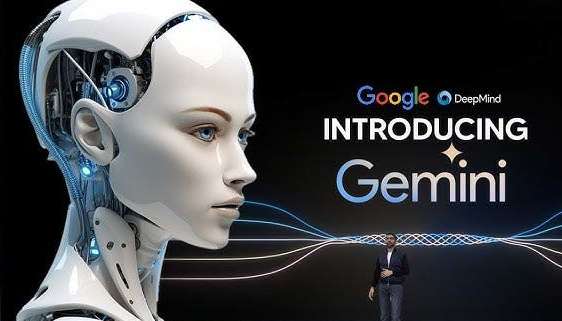Over the last few months, it seems as if there is a new development in the world of AI every other day. With every development being seemingly defined as seismic, groundbreaking, or revolutionary, it can be difficult to truly grasp the extent of AI technological progress. However, Google’s Gemini, the company’s most ambitious and powerful language model ever marks a significant leap in AI technology. Gemini isn’t just another language model; it’s a multifaceted mind capable of processing information beyond text, encompassing images, audio, video, and even code. And Google wants Gemini to be used by everyone, which is why it has been launched in three distinct forms, each tailored for specific needs: the powerful Ultra, the versatile Pro, and the efficient Nano.
Unlike traditional language models, confined to the realm of text, Gemini can seamlessly navigate across diverse data streams.
The Genesis of Gemini
Google’s AI and ML genesis is older than you would think. Back in 2001, Google integrated ML technologies for the first time in Google search to suggest better spellings for web searches, letting users get the results they wanted even if they couldn’t type their queries perfectly.
However, it wasn’t until the introduction of TensorFlow in 2015, that AI development began gathering pace. The open source machine learning framework made AI more accessible, scalable and efficient. This is evidenced by the fact that just a year later, AlphaGo became the first AI program to defeat a human world champion in the complex board game of Go. Since then, there was no looking back.
In the years that followed, Google drew on talents from Google Research and DeepMind teams to push the boundaries of deep learning and language processing. Custom-designed silicon chips known as Tensor Processing Units (TPUs) were invented to help train and run AI models at a much faster rate, facilitating development of large-scale AI applications. Google’s ‘Transformer’ served as the catalyst for modern day language models by revolutionizing translation, text summarization, and image generation by machines.
Fast forward to 2023, Google launched its first generative AI system – Bard – to compete with other large language models such as ChatGPT. Just a few months after launching Bard, Google introduced PaLM 2, a next-gen LLM that further enhanced multilingual, reasoning and coding capabilities.
All this has now culminated into the launch of Gemini, which is the first model to outperform human experts on MMLU (Massive Multitask Language Understanding). MMLU is one of the most popular methods to test the problem solving abilities of AI models; it is representrative of questions in 57 subjects including STEM, humanities, and others.
What Makes Gemini Unique
Gemini’s defining characteristic is its multimodal prowess. Unlike traditional language models, confined to the realm of text, Gemini can seamlessly navigate across diverse data streams. It can decipher the nuances of an image, understand the emotional undertones of a voice, and even analyze the intricate patterns of code. It has the potential to transform any type of input into any type of output. This opens up a world of possibilities, allowing Gemini to interact with the world in a way that mimics human cognition.

Gemini, however, isn’t a single entity; it’s a family of models catering to different needs.
- At the apex stands Gemini Ultra, designed for tackling the most complex tasks with state-of-the-art performance. It excels in tasks requiring in-depth reasoning, like medical diagnosis or scientific research. The architecture of Gemini allows Ultra to be efficiently serveable at scale on TPU accelerators.
- Gemini Pro, the versatile middle child, strikes a balance between power and efficiency. It can handle a wide range of tasks, from generating creative text formats to summarizing complex documents. Pro is performance-optimized in terms of cost as well as latency to produce optimal performance.
- Finally, Gemini Nano prioritizes efficiency for on-device applications. Its compact size and minimal resource requirements make it ideal for powering smart assistants on mobile devices. Nano was trained through distilling from larger Gemini models, which facilitates best-in-class performance.
According to DeepMind CEO Demis Hassabis, Google is already looking into how Gemini can be improved further by combining it with robotics to physically interact with the world. Speaking about Gemini’s future plans, he said, “To become truly multimodal, you’d want to include touch and tactile feedback. There’s a lot of promise with applying these sort of foundation-type models to robotics, and we’re exploring that heavily.”
Google Reimagined
Gemini is having an instant impact on Google’s suite of products, transforming how we interact with them.
- Bard, the conversational AI, now leverages Gemini’s capabilities for enhanced text understanding, leading to more natural and informative dialogues. Further developments are expected as the Gemini-Pro version of Bard is only able to process and generate text for now, despite the AI’s capabilities.
- Even the Pixel 8 Pro smartphone boasts new features powered by Gemini, like real-time translation of foreign languages during video calls, summarizing audio files in its Recorder app, and generating quick replies to texts via Gboard.
- Google has also begun testing Gemini in Search which has reduced the latency of Search Generative Experience responses by 40%.
This is just the beginning; Google plans on integrating Gemini across its various products and services, from Ads and Chrome to future iterations of Android and beyond.
Gemini’s Groundbreaking Performance
Gemini has been outpefroming its rivals such as GPT-3.5 and GPT-4 in benchmark tests already. It is surpassing the Open AI-led models in areas like reasoning, factual accuracy, and code generation. Its multimodal capabilities give it an edge in tasks that require understanding beyond mere text.
Gemini Ultra has smashed performance records on 30 out of 32 prominent academic benchmarks used in LLM research and development. Notably, it achieved a groundbreaking 90.0% score on the MMLU test, surpassing even human experts for the first time. This landmark achievement underscores Gemini Ultra’s exceptional capabilities in both comprehension and reasoning across diverse language-related tasks.
When tested on image benchmarks, Gemini Ultra excelled without relying on conventional OCR systems that convert text within images for analysis. This remarkable feat showcases its inherent multimodality, meaning it can directly and effectively process visual information without needing textual conversion. This hints at the development of more sophisticated reasoning abilities within Gemini Ultra, opening doors for exciting future applications.
The Need for Safety First
Despite all the excitement around AI development, user safety and ethical considerations need to be kept in mind.
Google claims that Gemini has the most robust safety evaluations of any Google AI product to date. Researchers delved into areas such as cyber-offense, persuasion, and autonomy, proactively exploring potential opportunities that may cause harm. This multi-pronged approach is a good start for AI safety and demonstrates Google’s commitment to responsible development and deployment.
However, challenges remain in areas like generating accurate information, particularly in sensitive domains like healthcare or finance. The process of building trust in the new era of AI is ongoing, requiring constant vigilance and collaboration with experts from various fields. This is evidenced by the fact that Gemini Ultra has only had a limited release since it is still undergoing safety checks.
A Catalyst for Progress
The impact of Gemini is far-reaching, extending beyond just the tech industry. Its potential to revolutionize sectors like science, finance, and education is undeniable.
Imagine personalized learning tailored to individual strengths and weaknesses, powered by Gemini’s understanding of each student’s unique needs. Real-time feedback, interactive tutoring, and adaptive curriculums could become commonplace, fostering a deeper love for learning and unlocking hidden potential.
Gemini’s ability to analyze medical data and understand complex scientific concepts could empower doctors with AI-assisted diagnoses and personalized treatment plans. Imagine scenarios where early disease detection becomes routine, and even rare ailments find potential cures with the help of Gemini’s computational power.
With seamless multilingual understanding and translation, Gemini could erase communication barriers and foster global collaboration. Real-time interpretation in meetings, live subtitles for foreign films, and instant translation of documents all become potential realities, bringing nations and cultures closer together.
Gemini’s ability to generate text, code, and even artistic visuals could become a potent tool for human inspiration. Imagine musicians collaborating with AI-generated melodies, writers seeking plot twists from Gemini’s creative engine, or architects brainstorming with AI-powered concept sketches.
On a more personal level, imagine voice assistants that truly understand your needs, smart homes that anticipate your preferences, and personalized news feeds that curate information relevant to your interests. Gemini’s integration into devices could create a world where technology seamlessly blends with our lives, making everyday tasks simpler and more efficient.
Google CEO Sundar Pichai is also bullish about the future that AI tech such as Gemini could lead to, “I believe the transition we are seeing right now with AI will be the most profound in our lifetimes, far bigger than the shift to mobile or to the web before it. AI has the potential to create opportunities — from the everyday to the extraordinary — for people everywhere. It will bring new waves of innovation and economic progress and drive knowledge, learning, creativity and productivity on a scale we haven’t seen before. That’s what excites me: the chance to make AI helpful for everyone, everywhere in the world.”
Conclusion
Gemini stands as a testament to Google’s unwavering commitment to pushing the boundaries of AI. It represents a paradigm shift in how we interact with machines, paving the way for a future where AI seamlessly complements and augments human capabilities. Beyond its technical prowess, however, Gemini raises crucial questions about trust, ethics, and the responsible development of AI. As we navigate this new landscape, it’s critical for all of us to remember collectively help ensure that advancements in AI benefit all of humanity, serving as a force for good.
____________
Written by: Nimesh Bansal





